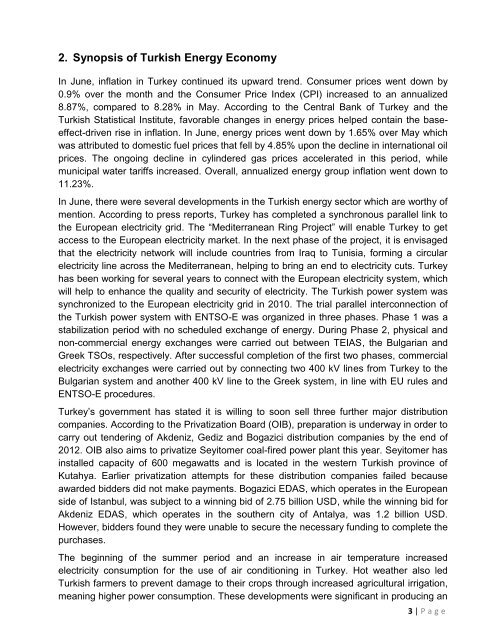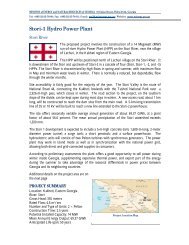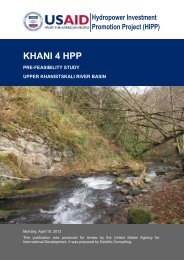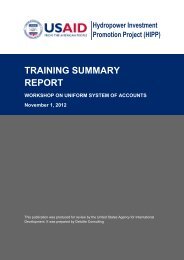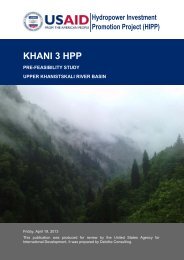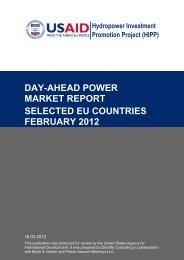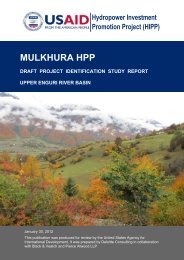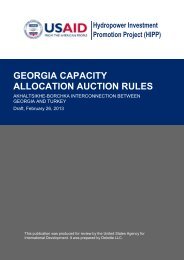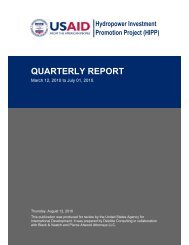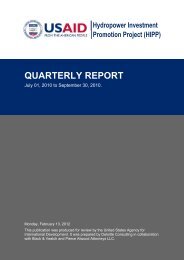Turkish Power Market Monthly Report (June 2012) - Hydropower ...
Turkish Power Market Monthly Report (June 2012) - Hydropower ...
Turkish Power Market Monthly Report (June 2012) - Hydropower ...
You also want an ePaper? Increase the reach of your titles
YUMPU automatically turns print PDFs into web optimized ePapers that Google loves.
2. Synopsis of <strong>Turkish</strong> Energy EconomyIn <strong>June</strong>, inflation in Turkey continued its upward trend. Consumer prices went down by0.9% over the month and the Consumer Price Index (CPI) increased to an annualized8.87%, compared to 8.28% in May. According to the Central Bank of Turkey and the<strong>Turkish</strong> Statistical Institute, favorable changes in energy prices helped contain the baseeffect-drivenrise in inflation. In <strong>June</strong>, energy prices went down by 1.65% over May whichwas attributed to domestic fuel prices that fell by 4.85% upon the decline in international oilprices. The ongoing decline in cylindered gas prices accelerated in this period, whilemunicipal water tariffs increased. Overall, annualized energy group inflation went down to11.23%.In <strong>June</strong>, there were several developments in the <strong>Turkish</strong> energy sector which are worthy ofmention. According to press reports, Turkey has completed a synchronous parallel link tothe European electricity grid. The “Mediterranean Ring Project” will enable Turkey to getaccess to the European electricity market. In the next phase of the project, it is envisagedthat the electricity network will include countries from Iraq to Tunisia, forming a circularelectricity line across the Mediterranean, helping to bring an end to electricity cuts. Turkeyhas been working for several years to connect with the European electricity system, whichwill help to enhance the quality and security of electricity. The <strong>Turkish</strong> power system wassynchronized to the European electricity grid in 2010. The trial parallel interconnection ofthe <strong>Turkish</strong> power system with ENTSO-E was organized in three phases. Phase 1 was astabilization period with no scheduled exchange of energy. During Phase 2, physical andnon-commercial energy exchanges were carried out between TEIAS, the Bulgarian andGreek TSOs, respectively. After successful completion of the first two phases, commercialelectricity exchanges were carried out by connecting two 400 kV lines from Turkey to theBulgarian system and another 400 kV line to the Greek system, in line with EU rules andENTSO-E procedures.Turkey’s government has stated it is willing to soon sell three further major distributioncompanies. According to the Privatization Board (OIB), preparation is underway in order tocarry out tendering of Akdeniz, Gediz and Bogazici distribution companies by the end of<strong>2012</strong>. OIB also aims to privatize Seyitomer coal-fired power plant this year. Seyitomer hasinstalled capacity of 600 megawatts and is located in the western <strong>Turkish</strong> province ofKutahya. Earlier privatization attempts for these distribution companies failed becauseawarded bidders did not make payments. Bogazici EDAS, which operates in the Europeanside of Istanbul, was subject to a winning bid of 2.75 billion USD, while the winning bid forAkdeniz EDAS, which operates in the southern city of Antalya, was 1.2 billion USD.However, bidders found they were unable to secure the necessary funding to complete thepurchases.The beginning of the summer period and an increase in air temperature increasedelectricity consumption for the use of air conditioning in Turkey. Hot weather also led<strong>Turkish</strong> farmers to prevent damage to their crops through increased agricultural irrigation,meaning higher power consumption. These developments were significant in producing an3 | P a g e


